Earlier this month, a group of biohackers installed two Rasberry Pis in their legs. While that sounds like the bleeding edge, those computers were already v2 of a project called PegLeg. I was fortunate enough to see both versions in the flesh, so to speak. The first version was scarily large — a mainboard donated by a wifi router roughly the size of an Altoids tin. It’s a reminder that the line between technology’s cutting edge and bleeding edge is moving ever onward and this one was firmly on the bleeding edge.
 How does that line end up moving? Sometimes it’s just a matter of what intelligent people can accomplish in a long week. Back in May, during a three-day biohacker convention called Grindfest, someone said something along the lines of, “Wouldn’t it be cool if…” Anyone who has spent an hour in a maker space or hacker convention knows how those conversations go. Rather than ending with a laugh, things progressed at a fever pitch.
How does that line end up moving? Sometimes it’s just a matter of what intelligent people can accomplish in a long week. Back in May, during a three-day biohacker convention called Grindfest, someone said something along the lines of, “Wouldn’t it be cool if…” Anyone who has spent an hour in a maker space or hacker convention knows how those conversations go. Rather than ending with a laugh, things progressed at a fever pitch.
The router shed all non-vital components. USB ports: ground off. Plastic case: recycled. Battery: repurposed. Amazon’s fastest delivery brought a Qi wireless coil to power the implant from outside the body and the smallest USB stick with 64 GB on the silicon. The only recipient of PegLeg version 1.0 was [Lepht Anonym], who uses the pronoun ‘it’. [Lepht] has a well-earned reputation among biohackers who focus on technological implants who often use the term “grinder,” not to be confused with the dating app or power tool.
V1: Implanting a Router Board
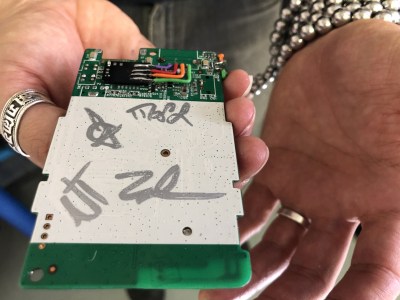
[Mixæl Laufer], [Nick Titus], and [Zac Shannon] were the hands-on folks who performed the delicate deconstruction so nothing would prevent the coating from adhering. Anything that goes inside the body must be protected, or there will be trouble. [Cass] developed a biocompatible resin for just such an occasion, and the formula underwent rigorous testing before Pegleg was even a thought. [Cass] is a nurse in California who hosts Grindfest at his home where he has a lab and surgery room that would turn some hackerspaces green with envy.
[Nick Titus] was in charge of optimizing the hardware and minimizing the failure points. Goodness knows when we build something and it stops working, we check our own work first and having one person labor over every solder joint, and stress point. This due diligence (and beyond) is wise for an implant.
Every time I did another mod on the hardware, I’d try and test it again, and the stakes would go up.
—[Mixæl]
I took some pictures while [Mixæl] cradled the uncoated v1 in both hands like it was a baby bird. I knew this was a bit of future-history, and the gravity of it will stay with me forever. The members even signed the silkscreen at the insistence of [Lepht] who reported zero problems with the implant after ten weeks. The actual implantation happened after the official end of Grindfest, but the procedure did make [Lepht] miss its flight, and the airlines were unkind to someone fresh out of surgery.
Raspberry Pi Zero’s Turn to Go Under the Skin
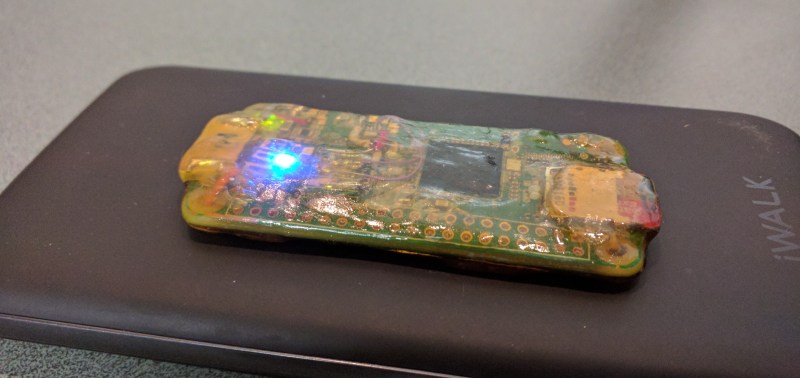
But hey, who’s still using router PCBs these days? The board-du-jour is the diminutive Raspberry Pi Zero. At DEF CON 27, I got to see and hold Pegleg v2 which shrank to a Pi0W (Raspberry Pi Zero W) with a Qi receiver, capacitor, wifi dongle, and half of a terabyte for storage. Three of them were made for implantation during the conference.
[Lepht]’s model went into its arm, near a rook tattoo, but the last two went into the upper thigh of [Mixæl] and [Cass] who planned the site based on where a Qi battery pack would sit in the pocket of their favorite pants. [Cass] implanted both devices, so if you think you’re metal, ask yourself if you could install a computer in your own thigh.
Decentralized Filesharing and Other Tricks of These Implants
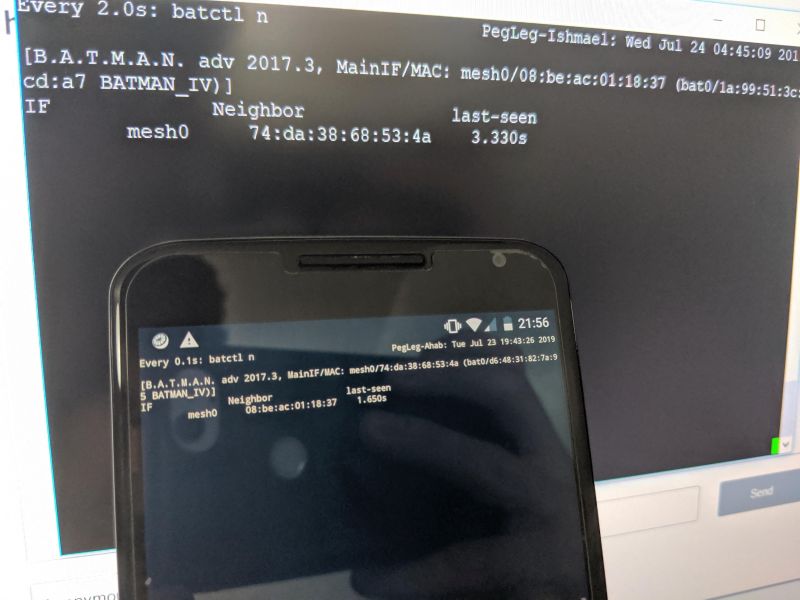
Each Pegleg runs a distro of PirateBox so while it is powered, any end-users with a WiFi device can connect to find an anonymous chat room, file server, and a video of the installation surgery if the owner kept it. PirateBox is under threat of vanishing without support, so if that is your jam, hit them up. The self-contained server does not require Internet access but relies on mesh networking to connect users. Implanted memory and networking seems like science fiction and speaking of sci-fi, these biohacks grabbed the attention of [William Gibson] who has an idea or two about humans carrying encrypted data. Johnny Mnemonic anyone?
If we have a mesh network, it could eventually replace the centralized Internet, and have all the things that we thought the Internet would have but now lacks because of centralization. It can be easily shut down, censored, surveilled…and it costs to access.
—[Mixæl]
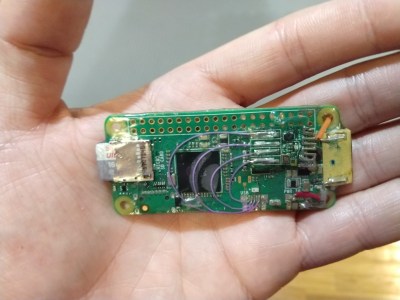
Hardware was not the only thing to change from v1 to v2. The software was modified by [Zac] who made the Pegleg distro and got mesh networking running. The best description for his work is “software research, configuration, and testing,” but techno-wizardry would also suffice.
Multiple units went through the tool shop under [Nick]’s hands, who also organized logistics which he would fondly call “Wet angry cat herding.” Seriously, try getting a bunch of hackers to all do the same thing on a regular basis. Hardware optimization was still at the front of his plate and off the top of his head, [Nick] was able to tell me the number of solder joints (fourteen) in the second version and if you don’t need mesh networking, you can get by with just six.
Where We Are Now With Computing Impants
I spoke with [Nick] about the whole process. He feels that implanting a PegLeg is a form of expression more than a logistical necessity. He also recommended that anyone interested in making an implant at home should try to avoid batteries and he detailed the complexities of containing a rechargeable battery with their heat problems, expansion, and compression foam, before stopping himself from proselytizing. Understanding the entire system that makes up the implant is vital. For instance, he spotted some missing admin functions that would have allowed anonymous users to upload files at will, but they could not be deleted.
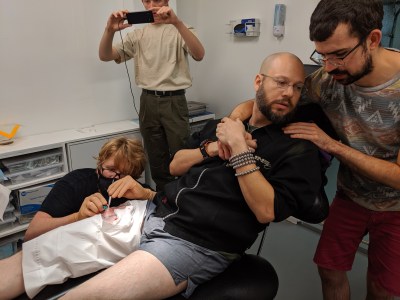
There are plans for a third version, and the goal is to make it the same area as a postage stamp but thicker. Research into wireless charging through metallic skin decals and other hardware platforms is in their future. There are no plans for a Kickstarter or any monetization, but you can freely find the exact recipe at their site. If you believe PegLeg is the coolest thing ever, they accept donations, and if you think PirateBox deserves some love, they need developers if they are going to stay afloat.
On the lighter side, when you say, “No more pie for me, it goes right to my hips,” you can think of the folks who let the Pi go right to their thighs.
Thank you, [cyberlass] and [SmokeLegend] for the tip.

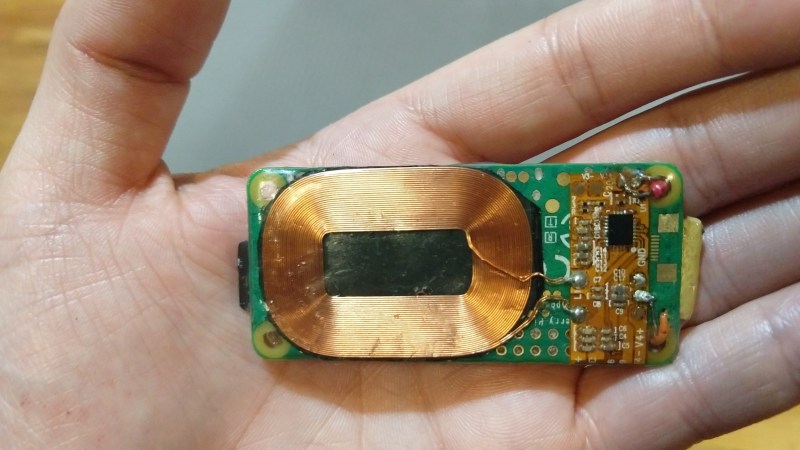














Enter Robocop, stage left..
After thinking on this for a while, we already make use of a removable implants.
My wife has a pacemaker, not really removable, but not maintenance free either.
And just remember all the cell phones smuggled into jails and prisons.
Implanted and then removed.
I know, shitty topic..
A pacemaker is needed for sustaining life, and it’s better that it gets implanted inside the body.
Smuggling cell phones is also a necessity for the inmate, and for him there are not practical alternatives.
But, when a biohacker get a file server implanted under his own skin, this is not a real life necessity.
That’s just a hype, and a useless one, as the device needs a non-trivial power source. Without a inductive, external power source, this is just a useless implant.
It has an external power source. The Raspberry Pi has a wireless charging coil on it as well as a capacitor which means it can be powered through the skin and will hold a charge.
Totally awesome with a big fat side of noooopppeeee.
I’m with you. This is certainly awesome, but I won’t be in line for the alpha testing. But at the same time, if you told me you were developing some electronics that you’d implant in your body to shock your heart when it needed a little help I would have looked at you like you were crazy.
These things all start somewhere. Really good ideas usually grow out of some larger ambition, and I think Brian’s right that we’re witnessing a little piece of history here.
Not awesome.. stupid and foolish. There is no practical reason to do this. There is nothing the Pi is doing that is a) furthering any understanding of human biology or b) can’t be done outside the skin rather than in. Medical researchers are all over electronic implants – for practical purposes, eg. when a sensor needs to be near the blood or bodily fluid full time. And even then, doctors implant just a sensor with a data management device in a wearable for… wait for it – health and safety concerns! These guys essentially just want to shove an glorified IRC server in their thighs. They are bio-daredevils; nothing more.
This made my IQ drop just reading it. gj
exactly, we do not have the tech to make this meaningful
awesome | ˈôsəm |
adjective
extremely impressive or daunting; inspiring great admiration, apprehension, or fear: the awesome power of the atomic bomb.
• informal extremely good; excellent: the band is truly awesome!
I think awesome still qualifies.
maybe I’m a “tad” to physical
I was going to get a friendly vet to implant an RFID thingo in me
where do you put it?
back of your hand is a bad idea, it’s a chunk of glass!!
I’ don’t know about you guys, but I take some pretty heavy hits
any idiot can hurt themselves, to do it with the frequency I do takes a lot of patience, practice and bit of contempt for the “meat”
as an aside
“Go hard or go home/possibly the ER” DOES take it’s toll, I’m 57 this year and it is all adding up….
People who are inclined to do such things usually implant RFID tags in the web of flesh between the thumb and index finger.
I thought of that
just didn’t feel safe
handle bars, ladders, winch handles, that sort of thing
plus random crush injuries
my right hand is a mess, the vet was not comfortable with any bit of an arm
these things are basically a chunk of glass, having one break under the skin is not something I’d want
Destructive testing showed that the force needed to crush an RFID chip inside a person would result in such severe tissue damage that the glass would be of little concern.
For proof, but a cheap one meant for pets and put it under the skin of some grocery store chicken. Now hit it with a hammer until the glass breaks. Look at the surrounding chicken and see if you agree.
I have an RFID installed in the usual spot between the thumb and index. Its also my second one as my first one did break. I was in a car accident which knocked the car on its side, as this happened my hand went out the window and for a moment was squished between the road and the a pillar. Didnt break any bones, just rubbed off some skin. Hand is perfectly fine. Broken the glass of the RFID tag though. Luckily I work at the hospital and lived in the same complex as a surgeon so once the swelling went down he picked it out for me.
Mine have never been damaged, with a couple of years of general hands-on building, hammering, milling, making etc.
You are using the term “glass” a lot, it isn’t that simple, you are taking the word “glass” from “fiberglass” and thinking “Oh, it’s glass, so it’s fragile” and yes you are right in that it’s a form of glass, it’s glass mixed with fibers to make it really hard. Anyway let me talk about the actual strength of fiberglass and how bio-safe it really is. Fiberglass is used in industrial applications where strength is a requirement and where there’s no room for fragility, fiberglass is also used in the medical industry for example to create moulds for broken bones and for radiotherapy masks as well as other things, the stuff is very bio-safe, it doesn’t break easily and it certainly doesn’t shatter and end up in the body as shards. You are very safe to implant a chip into your body even if your working life is very heavy duty, with the chip going into a web of skin between your index finger and thumb it will be a very difficult place to actually hit the chip. If you did something that crushed your index finger and thumb then the chip would indeed be crushed with it but by that point you might as well not worry about the fact that the chip got crushed inside you because you have serious injuries of crushed bones on your hand anyway and all will get dealt with in one go. Anyway I hope this helps. :)
The Mark of the Beast V0.2.5.1
Please explain.
Revelation 16:2 and 19:20
https://www.google.com search, “Mark of the Beast”
I don’t see where you are making the connection between this and an implanted computer. The mark was not described in the passages you suggested, or Revelations 13 which I often see referenced in this context. Can you explain why this is the Mark of the Beast as opposed to anything else?
I always thought the “mark of the beast” was the barcode
[cyberteque][Brian McEvoy], it is also believed it will be an RFID (with or without a computer chip) implant. So, I’m just taking it a step further is all.
Of course, with a PRC style of “social credit” system using face recognition/biometrics, implants/tattoos would not be necessary, I suppose…
Bruh wtf, always the newest thing in technology is the mark of the beast ? come on
Only if implemented, will prevent those who don’t have it, from buying food, houses, clothes, from voting, from applying for work or benefits…
Again, China’s “social credit” system.
This message string has reached its response limit. If you would like, email me at
brianmcevoy@hackaday.com
I will be happy to continue this conversation.
Rev 13: 16-17 is pretty specific about it being about payment, and only if it’s in the right hand or forehead. I have chips in my left hand and torso that open doors and measure my temperature so I’m good though. Unless you’re saying the bible isn’t literally true?!?
If it was going under my skin I’d want controllable LEDs on it.
nanite tattoo ink!!!
I want a time display like in “In Time”
So can you put it in airplane mode for flights?
Easiest would be to have it off. After that it would have to be software settings, I imagine the PirateBox docs and forums would have that info. https://piratebox.cc
This is very reckless unless person doing the implant surgery is authorized to prescribe antibiotics. Sepsis and staph are nothing to play around with.
I kind of wonder if a Teensy + ESP32 would satisfy the use cases and be smaller than an RPi0. I wouldn’t object to designing a custom board specifically for something like this. With a custom board you could use eMMC instead of an SD slot and avoid a lot of the issues with air bubbles.
Or just, you know, be experienced in sterile surgical techniques. Can’t get infected when there’s no bacteria around to do the infecting *touches temple*
Erm… lots of surgery comes with a free course of antibiotics, even though they’re professionals in sterile techniques.
I think that has to do with the “cover your ass” mentality these days, half the time a doctor will say you have a virus and still prescribe antibiotics “just in case”.
I’ve also done plenty of amateur surgery on my fingers, cutting out metal silvers and foreign material or gluing deep cuts shut…never needed any antibiotics, I just clean everything with alcohol and Povidone-iodine.
Digging down to create a tract that will drain secretions naturally afterwards is far less prone to abscess formation than a sealed pocket containing inorganic material prone to biofilm formation, making it hard for the immune system to address and unable to drain.
So what exactly is the point of implanting compared to just building it in a wristband or strapped to the leg or something? I just don’t see the point in this particular project. At least with something like an magnetic implant you’re actually gaining something (the ability to literally ‘feel’ magnetic fields) in return. Here, the implanting serves no real purpose other than just ‘to be implanted’. You’d think they would want to implant something that provides some sort of enhancement that would be impossible to achieve unless it was implanted.
implanting a nickel plated neodymium magnet sounds like a really bad idea
Implantable magnets have a second, sometimes even a third, coating of biocompatible material. Yes, a plain nickel-coated magnet would be a bad idea. I have had two magnets for over five years now.
what is that like?
what can you do?
For me, it feels like a gust, like from a can of pressurized air, on the skin over the magnet. I love it. I use it for sensing magnetic fields, like from high-current electrical lines, motors, and anything with a permanent magnet.
One time at work, my team was trouble-shooting a panel and they asked for my help because I was the electrical engineer on the project and they were mechanical engineers, bless their hearts. My meter was a ten-minute walk away and probing the panel could take another twenty minutes. Instead, I was able to wave my left hand over the components and the transformer felt like a “dead spot,” because I expected to feel a strong field around it. That was immediately alarming. We traced the line back to a circuit breaker that was tripped and we had the panel functional again. The whole ordeal took me less than a minute without any tools but without my magnet, it could have taken an hour.
Stick himself to the refrigerator… duh!
Oh yes. That too. Naturally.
Any problems with medical imaging, e.g. MRI?
I’m not into implanting foreign objects in my body (though I appreciate the practicality of the recent titanium and PEEK additions) , but if an implanted magnet could give me a sense of direction, I might consider trying that.
Have you written a HAD article about it? Would be interesting to hear more examples of practical uses and any issues you find.
Plus how different is it to non-invasive alternatives e.g. supergluing one to your skin?
I have another article about finger magnets you may find…handy.
https://hackaday.com/2017/09/08/magnet-implants-your-cyborg-primer/
And he causeth all, both small and great, rich and poor, free and bond, to receive a mark in their right hand, or in their foreheads:
And that no man might buy or sell, save he that had the mark, or the name of the beast, or the number of his name.
What point are you making?
No one is forcing anything.
This is not in the forehead or hand.
It does not include the ability to buy or sell.
sounds like a barcode
There’s a semi-common wackadoo conspiracy theory in some religious circles that bio-implantation (especially of an RFID chip in the hand) is an interpretation for some Biblical scripture concerning the Mark of the Beast, aka, 666, aka Satan. The significance is that shortly before the end times, people will start bearing the “mark” and won’t be able to be saved when the revelation comes. So these nutjobs are concerned that people who get these chips are marking, and thus thus damning, themselves. This is in the same class as the crazies that believe lab-grown meat will erase your soul or whatever.
Biomed is quoting some of that scripture. Maybe he’s just referencing the same conspiracy theory, maybe he actually believes it. That’s not for me to say. I’m not really religious, but I do love a crazy conspiracy theory.
My wife has an implant and she seems like a devil..
Maybe it’s just me..
Okay, it’s a pacemaker for her heart.
I checked the serial numbers and no 666 anywhere to be found.
On a related note, how the “EFF” did the scriptures describe implanted bio medical devices when they didn’t know about germs and virus and such?
>On a related note, how the “EFF” did the scriptures describe implanted bio medical devices when they didn’t know about germs and virus and such?
They don’t, biomed’s quote is the entire description iirc.
I suspect the obsession with the mark of the beast being an RFID chip or implanted computer comes from the “Left Behind” series.
I originally had one in my left hand, but it’s not Mark of the Beast compliant so that I might buy or sell, so I had to get one for the right hand as well.
The file system on an sd card is the major weak point. The sd card will fail and the implant will be bricked.
Cool, but NO. Let’s see where this goes from here. Off to check PirateBox..
Indeed sudden loss of power is liable to corrupt the file system if it happens while writing to the SD on a normal PI. I don’t know whether this is mitigated with their OS. Isn’t that what a journalling file system is for?
As long as we live in a society where clothing is the norm implants will never be practical. small fall or tumble, tearing apart “bio” epoxy. Infection insues.
Surely you mean ‘In a society where we are required to move’ – because last I checked, being naked by no way prevents me from 1. falling, 2. cutting myself, 3. getting infections.
In fact, it assists in preventing all 3.
lol
give me an implant that can detect an “oopsie”, give me a hit of something to at least, possibly stand and get home or to help
Where is the input for a jump start ….when he croaks from Streptococcus aureus?
What the heck is Streptococcus aureus? Is that like Staphylococcus pyogenes?
OK, so I implant something in a body designed to last 75 years that will be obsolete in 6 months, yea, that makes sense.
People get tattoos that last a lifetime. This particular procedure gives you a rather powerful ARM processor. The Rpi 3. Granted not Nano. Can play PlayStation Games. And in this case is being used as a simple file server. As the article reads. If you wanted to move encrypted data securely. This is a great choice.
Obsolete in 6mos? That’s generally from a newer version being released, which I can get behind since they are indicating they want to make it smaller and better. It won’t stop the current version from working just fine though. They are proving out small implantable tech, which is great.
What really kills me is that they aren’t even optimizing for size! Seriously, this thing shouldn’t be any larger than a postage stamp!
Size of a postage stamp? Could you be more specific?
When someone mentions a stamp I can’t help thinking about the “Mother of Emirates” postage stamp. The original postage stamp entered the Guinness World Records after being measured at 1.36 x 1.77 meters.
youmay find some info here https://www.thefactsite.com/largest-postage-stamp
But some of you might also think of the world’s smallest stamp, which measures 8 mm by 9.55 mm (.315 inches by .376 inches). It was issued by Bolivar, a province of Columbia, in 1863 and is called the Bolivar 10c green.
A postage stamp, you know 1 / 9,738,297 of a football field.
New tech often starts large, they have significantly reduced the size from the first version and said they are looking to get it to postage stamp so it sounds like you all on are the same page — just takes a bit of time to get there.
Yeppers, and there’s already an SD card sized router comparable to the pi zero
https://hackaday.com/2016/06/30/transcend-wifi-sd-card-is-a-tiny-linux-server/
That’s cyberpunk AF.
Gonna be a hassle to fly or get an MRI though.
Happily flying shouldn’t be a problem, so far people with similar implants haven’t had issues. MRI though is certainly something that would need to be discussed with the doctor, the same conversation people with shrapnel, magnets, or medical devices would need to have.
BIG problem if you need an MRI. In fact, it probably will disqualify you from having that procedure accomplished. I would pass on anything implanted, unless it would significantly improve your health. These procedures are elective. It’s crazy to have one of these things put in, as you’ll be unable to use a potentially life saving technology. Of course, you can have it surgically removed, and then you could have an MRI. In an emergency situation…..hmmm.
It’s a factor to be considered, but it’s not that outrageous. We all have different risk tolerances. People have to weigh the ongoing use of a device against the less likely event of needing an MRI. For some, like you, it would only be favorable if it were for a critical health device. Others would be find it acceptable for a range of functions like communications, biometrics tracking, internal compass, lights under the skin etc. If there should be a need for an MRI then they would assess their choices — using a different procedure, removal etc. An emergency MRI would only be a problem if the person can’t inform the technician about metal in the body — and without being able to get that info they would be unlikely to do an MRI anyways. To shrink that slight risk further one could wear a medical bracelet. I think for some people the small risk is worth it, especially as there are many people who can’t get an MRI and they don’t have an upside for it — like full control and use of their own implant.
My wife has an implant, a VNS, or Vagus Nerve Stimulator. It’s used for epilepsy and/or depression. It’s about the size of a pacemaker, and is implanted in her chest in the same place as a pacemaker. It has a lead that goes up and wraps around the vagus nerve in the left side of her neck. Every three minutes it delivers 1.5uA for 10 seconds. These settings are programmable using a wand that she holds over her chest while the doctor uses a tablet to control/interrogate it. He can check the battery level (her first implant had to be replaced at 8 years when the battery got too low), check the impedance of the lead to the nerve (looking for damaged leads, they do occasionally break, requiring surgery), and programm the timing and current level. It has worked miracles for her treatment-resistant depression. She can’t have MRIs for anything that is not life-threatening, and when she does, a neurologist has to shut it off and give instructions to the MRI technician as to what coils can be used where on her body. I understand that if it is done incorrectly, the implant may have to be replaced. It was very hard to find anywhere that would risk this the one time she needed it, most centers just said “no.” I fear that anything home-developed would be even more electrically fragile, although the lack of a several inch wire leading up her neck might make it a little safer for the implant. As far as non-medical implants go, I’m waiting for something that gives me a solid benefit, and even then, I wouldn’t be an early adopter.
let me understand … i had a kidney trasplant, and i daily take a pill battalion (immunosuppressant) and you put a chinese chip not specifically created for human tissues under your skin .with a coil and RF signals .. smart? i dont think so
There’s no reason this implant would require anti-rejection meds like an organ transplant would.
The “RF signals” from this device are no more dangerous than a cell phone in your pants pocket.
That being said, you *are* right about it being not smart, though.
Why would it matter if the chip was made in China?
How long can it run without an external power supply and how big is that power supply? If the answers are “not at all” and “bigger than a Raspberry Pi Zero”, then why not just put the Pi in the PSU you’re stuck carrying around either way?
This project is 100% “because I can”, not because it makes any sense otherwise.
My understanding is that it can’t run without the power supply, and that having it external was to increase safety and security. For them, they are gaining an implant that provides a function they want. This functionality is not appealing for everyone, but it’s not meant to be. As one of the developers put it “PegLeg is a form of expression more than a logistical necessity”. I think its great they are proving out small implantable tech.
What do you do if you accidentally corrupt the SD card?
In the event of a corrupted SD card I imagine they would need to replace the device and review what happed to see if there is a way to prevent it. It might even lead to the next version being even more robust. Early adopters who can describe and evaluate what went wrong are a valuable and I’m glad the Pegleg team picked some people who will to do that.
So.. What happens when the SD card gets corrupted due to power failure? (those Qi receivers are a bit janky)
My initial thought was, what are the chances of this, leading to the need of an actual
‘peg leg”? Then again I think getting a tattoo isn’t very wise. However I’m left with, as long as doesn’t affect others , do what ye will, I just don’t want to hear any whining if something goes wrong though.
Some people seem to think that it’s “cooler” to make the implant huge, more invasive and more risky.
You really should just design bespoke hardware that is as compact as possible.
Look at the Raspberry Pi Zero, and how much real estate is taken up by those mounting holes, the SD card socket, the expansion header footprint (even if no header is mounted) and the USB and HDMI ports (the pads and layout and space for those connectors, even with the connectors themselves removed.)
Raspberry Pi Zero W already has integrated Wi-Fi… why are we adding a Wi-Fi module again?
SD card corruption on the Pi is a huge concern in this context… you really want a read-only boot filesystem.
Maybe something like TI’s AM335x Cortex-A8 would be a good choice.
Absolutely use the bare-bones for the minimal functionality you want, and use high density throughout the layout, 0402 components for everything (or smaller).
Raspberry Pi… you can’t even get a schematic for it, so the hacking you can do is quite limited. Do you really want a proprietary, undocumented Broadcom walled garden in your leg?
Maybe one of the Octavo modules if you can’t get it down to a similar size yourself.
0.8mm PCB obviously, or thinner – why use a 1.6mm PCB?
Maybe Freescale iMX series, like the iMX233 or something? You could start with something like Olimex’s OLinuxino iMX233 Nano… at least it’s open hardware. Take the existing layout, lose the connectors you don’t need, add the inductive charging, and really shrink it down as much as you can, then fab it on 0.8mm.
I know I’m late to this, and there is probably a more robust aug out there thanks to the efforts of Grinders, but regardless of that, I would like to get myself one of these, thing is, i have no idea of who i should try and contact about such an endeavor, since i live in Russia aka- Luddite central, and googling obviously doesn’t result with a roadmap. I know there is some sort of a community out there, but my search only yielded a bunch of get fit schemes and MLMs. I can understand if i have to go deep web diving for this, but if there are less convoluted options I’d be glad to hear one.
Go to https://biohack.me/ and then sign up to the forums.
I am on there myself, my username on there is Helenah and you are free to drop me a message on there, the community is great, they grind their bodies, they do other things such as chemistry changes and there’s a bit of talk about genetics too.
Cool AF, but without the ability to charge it its pointless. Plus you would want some decent battery life from it so you don’t have to charge it all the time.